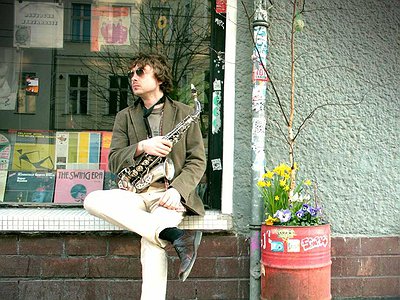Name: Philipp Gerschlauer
Nationality: German
Occupation: Saxophonist, composer, improviser
Current Release: Mikrojazz on RareNoise Records
Recommendations: “The Count Of Monte Cristo” by Alexandre Dumas. It is the most outstanding book I have read in a long time. The plot and narrative is so powerful, well thought and witty. I am waiting for the day it will become a Netflix series. It would be just perfect for it.
Website / Contact: If you enjoyed this interview with Philipp Gerschlauer, his informative website is a great point of departure.
When did you start playing your instrument, and what or who were your early passions or influences? What what is about music and/or sound that drew you to it?
I started to play saxophone at the age of seven. The teacher was my neighbour in my hometown, who'd learned to play the saxophone being a prisonor of war near Chicago after World War II. He came over every week to give me lessons and took me to the local marching band to play waltzes, polkas and marches. This was my first encounter with orchestral music and could be considered my first influence. I can recall my parents listening to classical music, especially Mozart and Beethoven from my early childhood on. My older brother used to play me classical recordings which I enjoyed a lot. Alfred Brendel's recording of the “Waldstein-Sonata” is still very close to my heart. When listening to this recording today I miss the sound a tape recorder produces.
So, having collected these early influences I wanted to play the saxophone from the age of four or five. I begged my parents for a long time and finally, at the age of seven, they bought me one. I got in touch with the saxophone through the Muppett show and their saxophonist. I think I was attracted by the strange form of the instrument and its weird shape. From the moment I got lessons everything went by itself. I don't recall my parents having to urge me to practice. I just played and played and played.
For most artists, originality is first preceded by a phase of learning and, often, emulating others. What was this like for you? How would you describe your own development as an artist and the transition towards your own voice? What is the the relationship between copying, learning and your own creativity?
Studying the tradition of music in general and jazz in particular was essential for my development and finding my voice. It's really like Parker said: “At first you have to learn your instrument, then the music and then forget everything and just play”. This describes the way I learned to play. This process took about twenty years. I wanted to learn to play the saxophone as well as possible. That is why I studied classical saxophone as a youthful student at the music university in Frankfurt. It was also a great way for me to explore a field of music which I probably wouldn't have had the chance to get to know to that extent in a later period of my career.
Emulating others belongs to a different field of studies to me. Emulating doesn't necessarily have anything to do with learning the technique. Learning the technique needs to come first, otherwise one is not able to emulate and to copy others. There are some saxophonists whom I emulated over the years until I almost “became” them. I copied them so much that I had to force myself to stop listening because I feared this would start to show on stage. But just for practising purposes emulating others is a great tool for developing one's own musical language. However, this is very hard to separate because when playing, one doesn't think about what has been practised but the muscle memory kicks in.
The first saxophonist I imitated was Richard Ludwig, the saxophonist sitting next to me in my hometown's marching band. He was famous for embellishing the melodies he played. Whatever was written out in his part – he embellished it. That was my first encounter with improvisation! I was eight. So I went home and tried to embellish the melodies myself and also played in this style at the orchestra. The others disliked that but I played it anyway. Which other outlet was there back then to explore music in the countryside in Germany?
When my mother married for a second time she married Adolf Klapproth, a New Orleans Jazz musician who played clarinet and trombone. I was thirteen at that time. He introduced me to Captn. John Handy who was a New Orleans saxophonist, recorded in the revival era. His recordings with the December Band from 1963 or recordings with his own band were the biggest influence of my childhood. His playing was virtuosic and expressive, shouting out his lines and really singing through his horn. Again varying the melody of the tunes he played, using riffs and lines that I was able to understand and copy.
Shortly thereafter I had my first encounter with Paul Desmond and Charlie Parker. Both almost at the same time. I still remember vividly how listening to this music felt. Desmond with Brubeck sounded slightly out of tune to me at first. I wasn't used to jazz chords back then. And Charlie Parker was full of energy and lines that clearly sounded out of tune.
I copied Paul Desmond's sound and tried to play lines like Parker. At first I didn't know anything about the rules in BeBop but then I came into possession of the “Charlie Parker Omnibook”. I played through all of the songs constantly. I practiced the lines, not knowing in which harmonic context they were placed. So these lines developed and transformed into other lines and textures which I would use to improvise. I played solo saxophone a lot at that time because there was no jazz band available in my early teens. Modern jazz music was just not a thing going on around my hometown. But through my step father I got to play New Orleans jazz a lot. So I somehow used Charlie Parker's lines in a New Orleans context. That was also due to the fact that in New Orleans jazz a player doesn't get many choruses in his solo. Being the young kid in the band I felt tempted be virtuosic and show off my technique in my playing. But deep in my heart I felt that this may not be the thing I really wanted to express.
After Desmond and Parker I checked out Coltrane. His music guides me still but more in a spiritual sense. Of course I studied his lines and harmony, but applying his methods to find my own melodic language – also in microtonality – is still the best method to define one's harmonic language. Coltrane's sound and they way he sings through his horn is so unique. He sounds like a preacher and that is also how I aim to sound when playing.
Finding my own voice was more a process of letting go. Of allowing the instrument to play itself. It's a process of asking questions without expecting answers, of stepping back and not getting in the way. I just told myself at one point: “It's ok how I play, it is my personality. And if I follow that path I will find my own voice”. And that's what I did, I think.
What were some of your main artistic challenges when starting out as an artist and in which way have they changed over the years?
One big artistic challenge was and still is that I am clearly labelled as being a microtonal saxophonist. I feel like people assume I am detached from the rest of the world just dealing with weird concepts and writing my music, but this is not the whole truth. I would consider myself being conservative. Conservative in a sense as not associating myself with the sound and style of the so called avantgarde. I like melodies, I like harmonies but I am bored of the harmonies existing in today's jazz. To me it sounds like everything has been done with 12 notes and I feel like we are back in 1750 when Baroque music had explored counterpoint to such an extent that classical musicians wanted to go back to simple structures and more emphatic melody and harmony. This is also how I feel. Today's music, be it jazz or contemporary, is so complex that I don't see the appeal in making it even more complex. This is why my music might sound more harmonious and singable to the listener. The theory and research behind it is complex but I don't want the listener to realize this. However I need this theoretical background in order for my music to sound the way it does. Otherwise it wouldn't work. So it's in between the zone of complexity and simplicity. One could call it “complex simplicity”. Finding musicians willing and able to commit to this music was not easy. That was a challenge for sure. Luckily I found people and there are more and more of them becoming interested in microtonality.
A different artistic challenge was playing the saxophone in a microtonal way, using fingerings. I learned this almost automatically whilst practising my own compositions. By playing the melodies over and over I was able to develop my own lines, my own melodies and also an emotional relationship to all of these lines. Expanding the fingerings from 48 to over 128 notes per octave took me about a year and required intense praticing. But that was just an assignment I gave myself. Much more interesting was the musical application of the new harmonic and melodic language which resulted from that development.
In order to play and to expand the harmonic possibilities I needed to develop a microtonal keyboard which I started doing in 2012. Labelling each key on the keyboard was not easy back then, keeping in mind that I am not a computer specialist. I just tried to find people to help me and luckily I was able to have it working within just less than a year.




